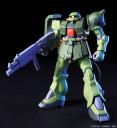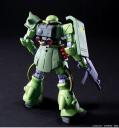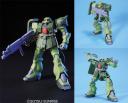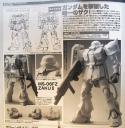Lately I’ve been working on the design of the belly part of the Zaku, and thinking about how I can improve the model’s posability a bit. Part of me feels like this is a waste of time – better to make the model look good than to make it posable, and poor posability can be overcome by creating a customized static-pose version of the model… Still, part of me wants to show off, I guess, and make my Zaku capable of a lot of what the new MG kits can do…
In terms of leg and hip posability for kneeling poses, the Zaku Kai has some advantages and some disadvantages relative to the new MG design… Its knees can bend pretty far, around 130 degrees, though the new MG’s knees can go a lot farther… The skirts are a problem, not so much because of their size as the fact that they are situated far enough forward that it’s hard to get the legs to clear them… And since I’ve kept the giant feet of the original design, that also complicates kneeling poses and seriously limits walking poses. On the bright side, the midsection has potential for a level of flexibility that can overcome a lot of the limitations of the hips and legs.
The midsection of the Zaku Kai is intended to represent some sort of flexible fabric cover concealing inner mechanisms. (You can see this in the MS Era book – there’s a shot of a wrecked Zaku.) I’m not going to implement it as a flexible part, but even with the belly built up as a rigid part, there’s enough clearance between the belly and the skirts that there’s a lot of potential for flexibility.
My design so far has been for a ball joint somewhere inside the belly part, with a rod extending down into the hips. The rod could then slide up or down to provide more clearance for different poses. Not the most convenient system admittedly but I expect it’ll look good and still provide a good level of posability. Initially I designed the belly part for the standing pose, and then posed it as I would the model (keeping the belly part rigid, rather than deforming it, to simulate how the model would work.) The problem with this was that by bending the belly part forward and to the side, and sliding it up enough so the cockpit could clear the front of the “belt”, a big gap opened up. To some extent this is unavoidable – it’s just a consequence of using a rigid part to represent a flexible one.
The new design I’m experimenting with has a few changes. First off, there’s a cuff that extends up from the hip area to hide as much of the belly part as possible without being too noticeable. Second, the belly part extends down lower, almost to where the legs meet the hips, when the Zaku is in a normal standing pose. The belly part tapers at the bottom, too – so that when the belly slides up for more clearance, it’s a narrower section of belly that coincides with the top of the cuff. Then when the belly tilts on its ball joint, the tapered area of the belly part moves to the edge of the cuff and the gap between the two is largely negated. The idea is to make it so that, instead of seeing an abrupt termination of the belly, the viewer instead sees a recession. Hopefully this will make the gaps opened by extreme poses less noticeable…
I did make a few mistakes in these images. In the first, the belly has a texture image, and the left foot is misplaced… In the second, the left foot is correctly placed, but the belly has no texture image – thing is, I haven’t yet adjusted the UVs for the belly part to correct its texture mapping, so for now I just cleared out the texture.


























